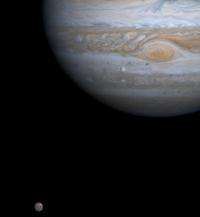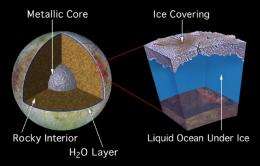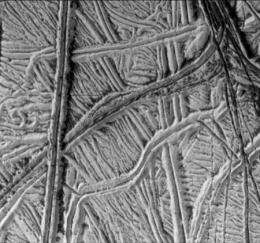Hunting for Fossils on Europa

Jupiter's moon Europa has a salty ocean where life could exist. A thick ice shell separates the ocean from our exploration vehicles, and it’s not known how far down we’d need to drill. But why drill at all, when evidence for life could be lying right on the surface?
If extraterrestrial life exists on Jupiter's moon Europa, instead of deploying probes to drill past its ice shell to look for aliens in the ocean below, one might just go fossil-hunting on the icy surface.
"A prospector sent there could possibly find extraterrestrial life within our lifetimes," suggested planetary scientist Richard Greenberg at the University of Arizona's Lunar and Planetary Laboratory at Tucson.
Europa, which is roughly the size of Earth's moon, is enveloped by a global ocean that may be about 100 miles deep (160 km). This ocean is overlain by an icy crust of unknown thickness, although some estimates are that it could be only a few miles thick. Since wherever there is water on Earth there is a chance of life, for many years scientists have entertained the notion that this Jovian moon could support extraterrestrials. Recent findings even suggest its ocean could be loaded with oxygen, enough to support millions of tons worth of marine life like the type that exists on Earth.
To see if any kind of life actually evolved on Europa, scientists have proposed missions to drill through its outer shell, perhaps using heat to melt through the ice, whirring blades to clear away rocks and robot subs to explore the ocean.
"With that vision in mind, NASA has a multi-staged plan, first with a Europa orbiter scheduled for 18 years from now, and 10 or 20 years after that, a lander to see what the surface is like, and then maybe a generation later, hopefully we can figure out how to drill all the way down through the ice," Greenberg noted. He recently wrote a book, "Unmasking Europa," which touched upon how one might search for life on the Jovian moon.
However, rather than deploying complex equipment to try and penetrate an uncertain distance into the ice, the remains of marine life on Europa could be available right on the outer shell for landers to find. Scientists aren't suggesting that any life from Europa somehow managed to dig its way up through the ice. Instead, the constant upheaval this Jovian moon undergoes could drag unwitting organisms upward, Greenberg explained.
The scarcity of craters seen on Europa suggests the ice shell is no older than 50 million years old, hinting that it underwent complete turnover in that time. The culprit for this extraordinary activity is the gravitational pull Europa experiences from Jupiter. This leads to tidal forces roughly 1,000 times stronger than what Earth feels from our moon, flexing and heating the Jovian moon and constantly stirring its crust.

Ice — probably newly frozen ocean water — apparently regularly gets pushed up from below, leading double ridges typically 330 feet high (100 meters) to form and cover at least half of Europa's surface. Parts of the surface also could partially melt from below, creating rafts of ice that break loose and tumble around.
This process creates the "chaotic terrain" that comprises roughly 40 percent of the ice shell, and also sends matter both upward and downward.
"If there are organisms in Europa's ocean, one could well imagine that all over the surface there might be frozen chunks of that stuff," Greenberg said. "People are talking about various kinds of drills and melting down through the ice, and I think we can jump past that and sample the ocean from the surface."
One of the best places to look for any fossils on Europa would be newly formed double ridges, Greenberg said. "The ridges that crisscross others are going to be the most recent ones," he explained. "One could then imagine landers scooping up the ice and analyzing it."
Chaotic terrain would also be another good area to explore, as would an active crack in Europa's crust. "If we can land right next to an active crack, there's a good chance we could sample some of the most recent ice," Greenberg said. "If we could put a penetrator into it, we could even sample water as it comes up."
If any microbes did manage to make their way to Europa's surface, the constant stream of radiation from Jupiter would likely break their proteins down over time, assuming such life would have proteins at all, said planetary geologist Brad Dalton at NASA's Jet Propulsion Laboratory.

Still, experiments of Dalton's have suggested orbiters could investigate the infrared signature of Europa's icy crust to look for tattered remnants of life. Landers could conduct even more detailed analyses — for instance, using "lab-on-a-chip" devices on melted ice samples to look for biomolecules, he added.
Also "there's always the possibility that we could find structures — something analogous to skeletal remains," Greenberg noted.
Dalton added that if landers dug "even a meter or so down might also be able to find viable organisms, if there are any there."
Of course, if there is life in Europa's ocean, it remains uncertain whether it would indeed get lofted up via geological processes to its surface. Conversely, if no life is seen on Europa's surface, that does not mean there is no life in Europa's ocean.
"My point is only why wait to look for life at the hardest place on Europa to get to?" Greenberg said. "Why not go to the easy place first?"
Source: Astrobio.net




















